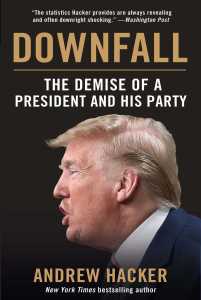
The Denver Post’s former downtown headquarters looms over the Colorado Statehouse. The Post itself now operates out of its printing plant in the suburbs. Photo (cc) 2021 by Dan Kennedy.
The McCarthy era is often cited as a time when the limits of journalistic objectivity were exposed for all to see. For years, the press reported Sen. Joseph McCarthy’s false claims that he had a list of communists in a straight-up, deadpan manner, reasoning that it was their job to inform the country of what a United States senator was saying, not to offer any judgments.
But that’s not what Walter Lippmann had in mind when he first defined objective reporting a century ago. As he conceived it, objectivity was not acting as a conveyor belt for the lies of the powerful; nor was it mindless balance. Rather, it was an objective, fair-minded pursuit of the truth. Once you had determined the truth to the best of your ability, your job was to report it.
“We tell people in a forthright and unflinching way what we have learned because we’ve done the reporting,” retired Washington Post executive editor Marty Baron said at a virtual appearance at Northeastern earlier this year. Baron defined objectivity as “independence and open-mindedness and a posture of listening and learning.”
Recently I read a book as part of my research into local news that is about as obscure as you can imagine: “Thunder in the Rockies: The Incredible Denver Post,” written by Post staffer Bill Hosokawa and published in 1976. And I was struck by how courageously the Post stood up to McCarthy — especially since, in previous decades, the Post had been mired in corruption and racism.
This post was part of last week’s Media Nation member newsletter. To become a member for just $5 a month, please click here.
By the time McCarthy came along, the Post’s editor was a stand-up guy named Palmer Hoyt, who was unflinching in his insistence on holding the Wisconsin senator to account. In a memo to his staff, he defined true objectivity in such a compelling way that it ought to be taught to every reporter. I’m not going to quote the entire memo, but here’s a key excerpt:
It is obvious that many charges made by reckless impulsive officials cannot and should not be ignored, but it seems to me that news stories and headlines can be presented in such a manner that the reading public will be able to measure the real worth or value and the true meaning of the stories.
For example, when it is possible and practical, we should remind the public in case of a wild accusation by Senator McCarthy that this particular senator’s name is synonymous with poor documentation and irresponsible conduct and that he has made many charges that have been insupportable under due process.
In 1954, Hoyt received the John Peter Zenger Freedom of the Press Award. In his acceptance speech, Hoyt continued to speak boldly, turning media critic: “It is true that the number of newspapers critical of McCarthy has grown during the last year or two. But there are still many of them who are his supporters, his apologists, even his devotees.” And he singled out the Chicago Tribune and the Hearst papers as particularly egregious offenders.
It hardly needs to be said that we are facing a crisis of democracy today — perhaps the most serious since the Civil War, as Robert Kagan recently wrote in The Washington Post (free link). The brainless objectivity of the 1950s has morphed into something else. As Thomas Patterson of the Harvard Kennedy School has written, Donald Trump received an enormous assist from the press in 2016 by portraying his grotesque behavior and corruption as being equal to Hillary Clinton’s shortcomings — you know, her emails.
Today, Trump and his supporters, who seek to destroy the integrity of our elections in order to pave the way for an illegitimate second Trump term, are getting plenty of harsh coverage, as they should. But to absorb this through the media is to see it balanced against the Democrats’ struggles over its infrastructure bills and chaos at the border. It’s all both sides and false equivalence.
As New York University journalism professor Jay Rosen has said over and over again, the press is not equipped to cover a reality in which one of our two major political parties remains its normal self and the other has lurched into authoritarianism. You can see it in the headlines this week describing the debt-limit crisis as something the Democrats are struggling to solve — as if it’s a given that the Republicans have descended into madness and therefore can’t be blamed.
We are living through an incredibly ugly time. At the very least, we should remember what Palmer Hoyt said about the media’s obligation to tell the truth.





